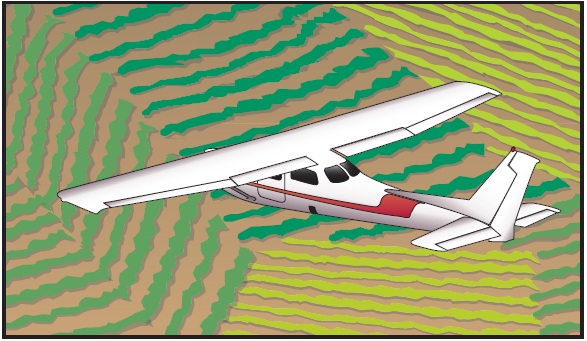
Chapter 16 Emergency Procedures
Table of Contents
Emergency Situations
Emergency Landings
Types of Emergency Landings
Psychological Hazards
Basic Safety Concepts
General
Attitude and Sink Rate Control
Terrain Selection
Airplane Configuration
Approach
Terrain Types
Confined Areas
Trees (Forest)
Water (Ditching) and Snow
Engine Failure After Takeoff (Single-Engine)
Emergency Descents
In-Flight Fire
Engine Fire
Electrical Fires
Cabin Fire
Flight Control Malfunction / Failure
Total Flap Failure
Asymmetric (Split) Flap
Loss of Elevator Control
Landing Gear Malfunction
Systems Malfunctions
Electrical System
Pitot-Static System
Abnormal Engine Instrument Indications
Door Opening In Flight
Inadvertent VFR Flight Into IMC
General
Recognition
Maintaining Airplane Control
Attitude Control
Turns
Climbs
Descents
Combined Maneuvers
Transition to Visual Flight

ATTITUDE AND SINK RATE CONTROL
The most critical and often the most inexcusable error that can be made in the planning and execution of an emergency landing, even in ideal terrain, is the loss of initiative over the airplane’s attitude and sink rate at touchdown. When the touchdown is made on flat, open terrain, an excessive nose-low pitch attitude brings the risk of “sticking” the nose in the ground. Steep bank angles just before touchdown should also be avoided, as they increase the stalling speed and the likelihood of a wingtip strike.
Since the airplane’s vertical component of velocity will be immediately reduced to zero upon ground contact, it must be kept well under control. A flat touchdown at a high sink rate (well in excess of 500 feet per minute (f.p.m.)) on a hard surface can be injurious without destroying the cockpit/cabin structure, especially during gear up landings in low-wing airplanes. A rigid bottom construction of these airplanes may preclude adequate cushioning by structural deformation. Similar impact conditions may cause structural collapse of the overhead structure in high-wing airplanes. On soft terrain, an excessive sink rate may cause digging in of the lower nose structure and severe forward deceleration.
TERRAIN SELECTION
A pilot’s choice of emergency landing sites is governed by:
- • The route selected during preflight planning.
- • The height above the ground when the emergency occurs.
- • Excess airspeed (excess airspeed can be converted into distance and/or altitude).
The only time the pilot has a very limited choice is during the low and slow portion of the takeoff. However, even under these conditions, the ability to change the impact heading only a few degrees may ensure a survivable crash.
If beyond gliding distance of a suitable open area, the pilot should judge the available terrain for its energy absorbing capability. If the emergency starts at a considerable height above the ground, the pilot should be more concerned about first selecting the desired general area than a specific spot. Terrain appearances from altitude can be very misleading and considerable altitude may be lost before the best spot can be pinpointed. For this reason, the pilot should not hesitate to discard the original plan for one that is obviously better. However, as a general rule, the pilot should not change his or her mind more than once; a well-executed crash landing in poor terrain can be less hazardous than an uncontrolled touchdown on an established field.
AIRPLANE CONFIGURATION
Since flaps improve maneuverability at slow speed, and lower the stalling speed, their use during final approach is recommended when time and circumstances permit. However, the associated increase in drag and decrease in gliding distance call for caution in the timing and the extent of their application; premature use of flap, and dissipation of altitude, may jeopardize an otherwise sound plan.
A hard and fast rule concerning the position of a retractable landing gear at touchdown cannot be given. In rugged terrain and trees, or during impacts at high sink rate, an extended gear would definitely have a protective effect on the cockpit/cabin area. However, this advantage has to be weighed against the possible side effects of a collapsing gear, such as a ruptured fuel tank. As always, the manufacturer’s recommendations as outlined in the AFM/POH should be followed.
When a normal touchdown is assured, and ample stopping distance is available, a gear up landing on level, but soft terrain, or across a plowed field, may result in less airplane damage than a gear down landing. [Figure 16-3]

Figure 16-1. Using vegetation to absorb energy.
Deactivation of the airplane’s electrical system before touchdown reduces the likelihood of a post-crash fire. However, the battery master switch should not be turned off until the pilot no longer has any need for electrical power to operate vital airplane systems. Positive airplane control during the final part of the approach has priority over all other considerations, including airplane configuration and cockpit checks. The pilot should attempt to exploit the power available from an irregularly running engine; however, it is generally better to switch the engine and fuel off just before touchdown. This not only ensures the pilot’s initiative over the situation, but a cooled down engine reduces the fire hazard considerably.
APPROACH
When the pilot has time to maneuver, the planning of the approach should be governed by three factors.
- • Wind direction and velocity.
- • Dimensions and slope of the chosen field.
- • Obstacles in the final approach path.
These three factors are seldom compatible.
When compromises have to be made, the pilot should aim for a wind/obstacle/terrain combination that permits a final approach with some margin for error in judgment or technique. A pilot who overestimates the gliding range may be tempted to stretch the glide across obstacles in the approach path. For this reason, it is sometimes better to plan the approach over an unobstructed area, regardless of wind direction. Experience shows that a collision with obstacles at the end of a ground roll, or slide, is much less hazardous than striking an obstacle at flying speed before the touchdown point is reached.
PED Publication